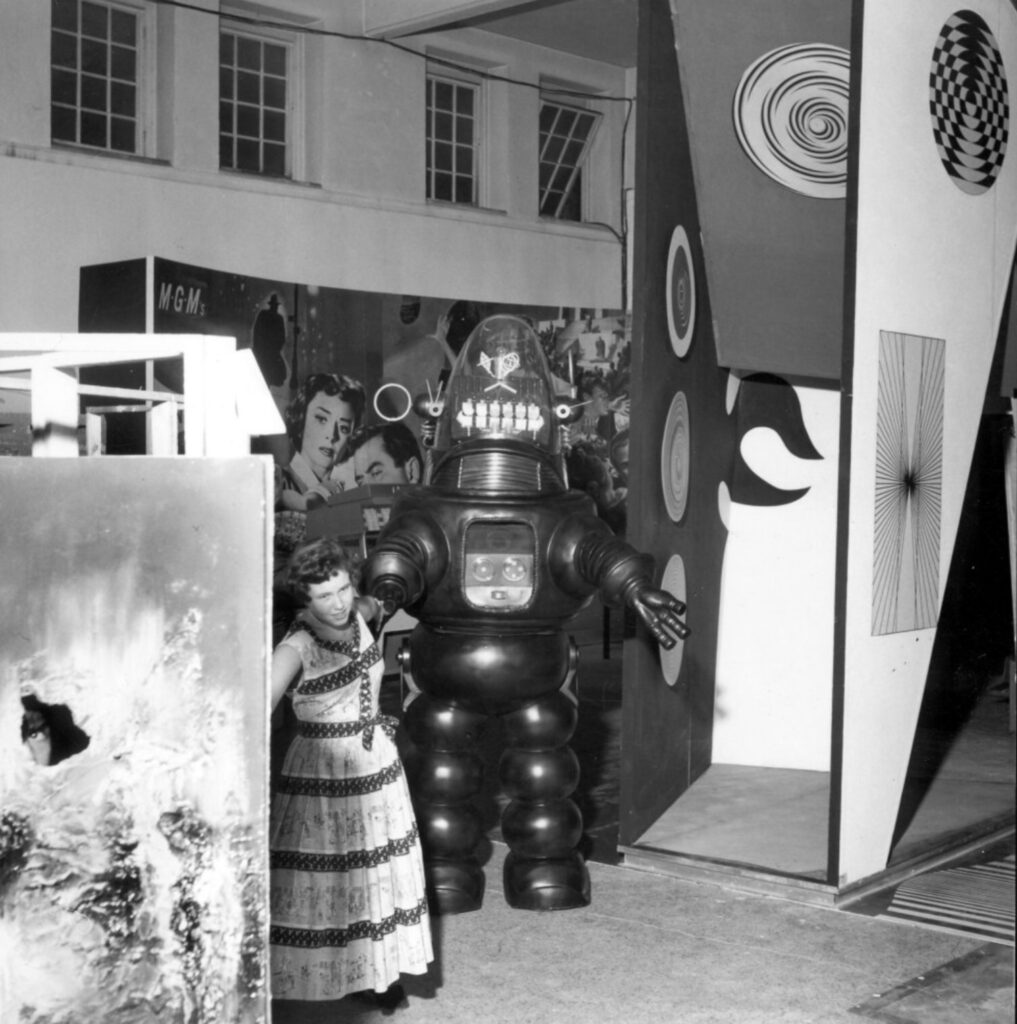
Back in 1956, London’s Whitechapel Gallery hosted the seminal exhibition “This is Tomorrow”, featuring members of the Independent Group of artists and critics. While it proved an inspirational event for artists, architects and others, it’s remembered by many outside the arts, including, perhaps, readers of Rocket comic, for the appearance of Forbidden Planet feature film star Robby the Robot at its grand opening.
Thanks to an item in a weekly boy’s comic of the time, Rocket, we now know his appearance may have been a happy confluence of artistic aspiration and ongoing film promotion.
The Independent Group was a highly significant collection of writers, thinkers and creative practitioners which met at the ICA from 1952 until 1955. Remarkable for its collaborative process, their “This is Tomorrow” exhibition pre-empted the emergence of Pop Art in Britain by nearly a decade.
Running between 9th August – 9th September 1956, its most remembered exhibit was the room created by Group 2, a collaboration by painter and collage artist Richard Hamilton, an early exponent of pop art, artist, art theorist, sociologist and future studies searcher John McHale, and architect John Voelcker, with help from artist Magda Cordell and composer Frank Cordell.
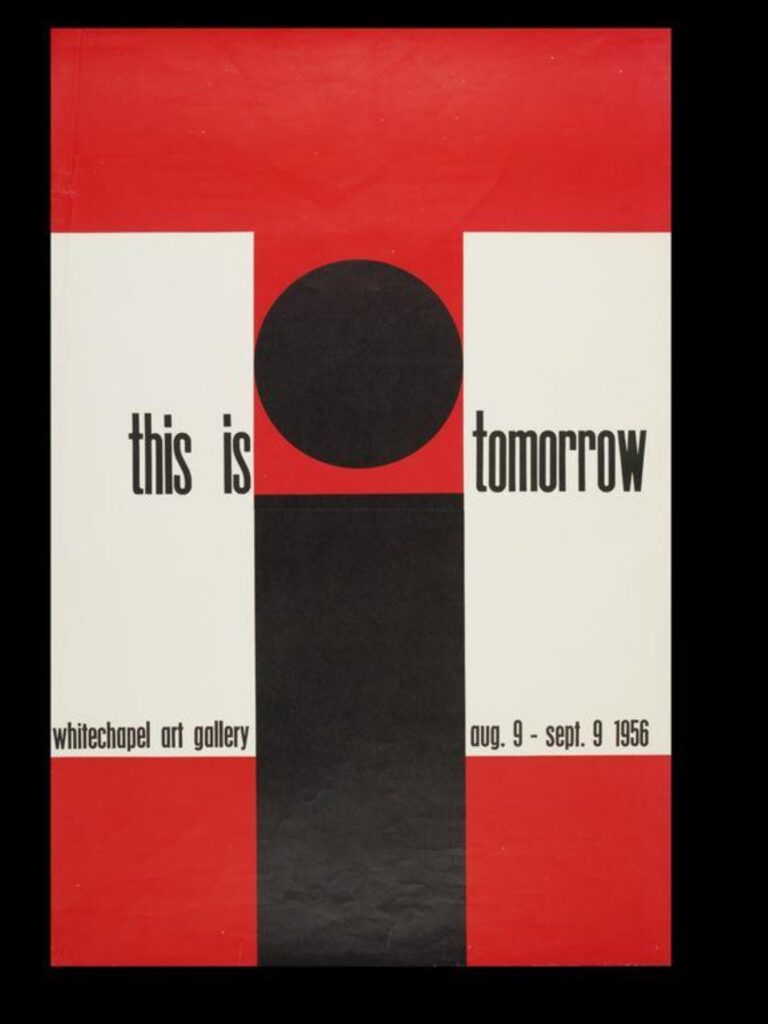

It included a huge image of Robby the Robot, painted by Hamilton, distilled from the film’s early posters, complete with “light up” eyes, “Op Art” dazzle panels, collage Space modules, a Jukebox, a strawberry perfumed carpet, a looped reel of film depicting the Royal Navy Fleet at sea, large Guinness beer bottles, a Marlon Brando poster image, and more.
In the book, Aesthetics of Plenty, it’s noted that Frank Cordell assisted McHale with accessing the film posters such as Julius Caesar for the collage murals, the Forbidden Planet items, the juke box, and installing the film projector, and installing Duchamp rotor discs given to McHale by Marcel Duchamp in New York.
Frank Cordell also installed the electronic amplifier and microphone enabling the ambient sounds from audience cybernetic feedback. The Senses panel with arrows featuring Yugoslavian leader Tito was a joint collaboration between Hamilton and McHale, and the version reproduced in the catalogue was slightly different in wording to alter the optical perception of viewers.
The organisers allotted gallery space to twelve groups of three to four creative practitioners, asking each group to produce work on the theme of modern life, on a very limited budget. Architects, artists, designers and critics took part in a project designed to challenge perceived boundaries between the visual arts and promote dialogue between practitioners.
In highlights from a 1979 documentary, artists and architects who were involved recall the sense of excitement they felt over the collaborations, the constraints of cost – only £50 was assigned to each group for materials – and their sense of the importance of the show within the context of the establishment they opposed.
According to the documentary, “viewers are invited to enter strange houses, corridors, and mazes. This is modern art to entertain people, modern art as a game people will want to play.”
The sense of involvement and fun carries through in press clippings about the exhibition, included in a representation at the Whitechapel Gallery in 2010. Journalists were most taken by the fact that the show was opened by Robby the Robot, star of the sci-fi movie Forbidden Planet and “easier to book than Marilyn Monroe”.
Robby’s appearance may have in part been helped by ongoing promotion of the feature film by MGM. Thanks to an item in the short-lived weekly comic, Rocket, cover dated 15th August 1956, we know “Robby” was on tour in Britain at the time.
Just where he appeared seems scantily documented, but it seems likely his appearance at the “This is Tomorrow” opening was one of his first dates, and no doubt helped the exhibition’s success outside of art circles, the event reportedly attracting thousands of visitors.
(Robby’s public appearances in America, including Las Vegas, and in Sydney, Australia, are much better known).
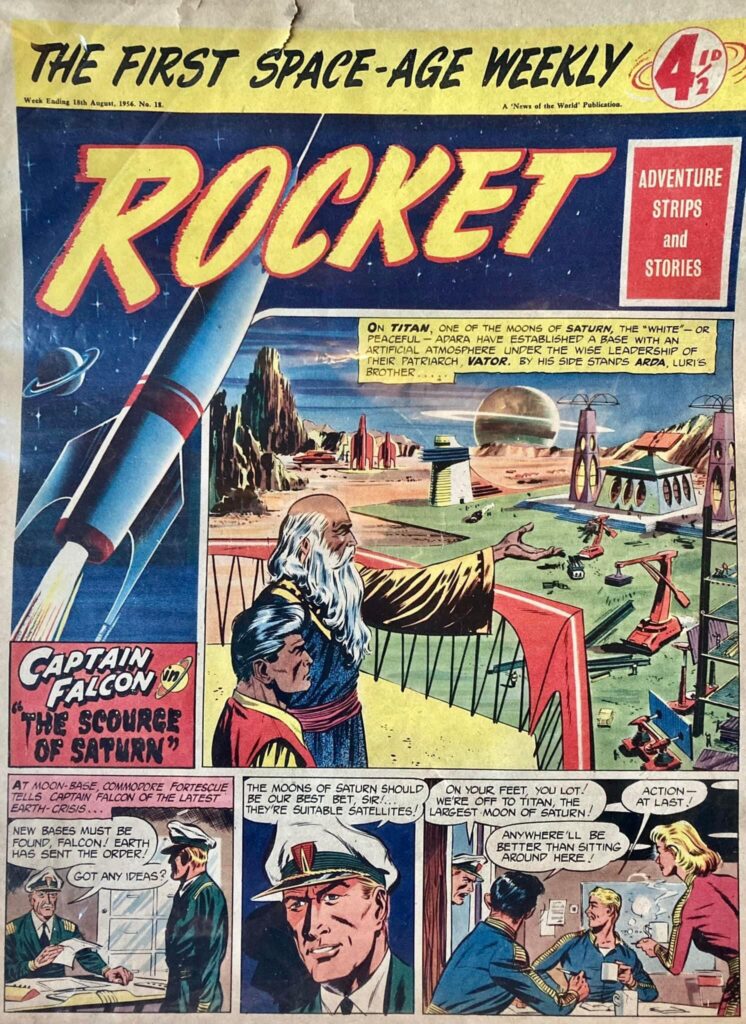



Although Pop Art is generally associated with the United States, with work by artists such Andy Warhol and Roy Lichtenstein immediate examples. the movement found an early voice in Britain as a critical and ironic reflection on the post-War consumer culture of the late 1950s, and “This is Tomorrow” served as its key starting point.
Now considered the cradle of pop art, with Richard Hamilton’s work, it was also the starting point for the challenging work of Alison and Peter Smithson, which united conceptual and formal forces with various other artists, painters, sculptors, and photographers. In a research paper published in 2018, “Architecture exhibitions: chronology of a modern cultural phenomenon and some inquietude”, Fernando Vazquez argues it also gave the Independent Group great visibility, also making way for the consecration of a new form of architectural expression – Brutalism.
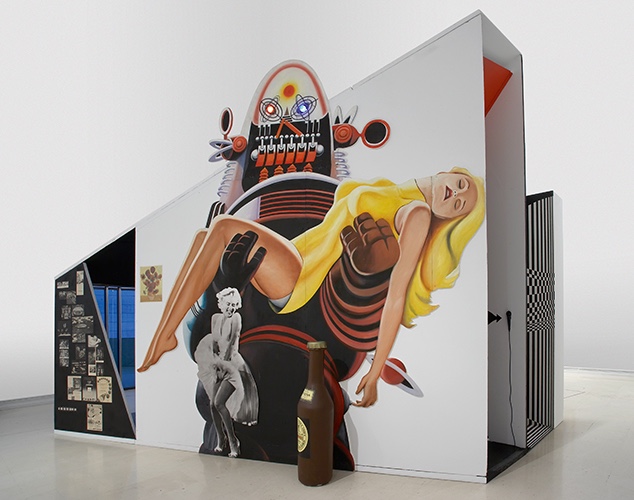
Lawrence Alloway, one of the participants as writer and theorist, commented of the groundbreaking exhibition : “movies, science fiction, advertising, pop music… We felt none of the dislike of commercial culture standard among most intellectuals, but accepted it as fact, discussed it in detail, and consumed it enthusiastically. One result… was to take pop culture out of the realm of escapism, entertainment, and relaxation, and treat it with the seriousness of art”.
The striking mural featured in the exhibition by Richard Hamilton was represented as part of a touring exhibition, British Pop Art, hosted by the Madrid’s Reina Sofía and the Kunstmuseum Wolfsburg.
As part of its 2010 celebration of the original exhibition, the Whitechapel Gallery also reissued the original 132-page catalogue, copies still available from their website.
Web Links
• Whitechapel Art Gallery “This is Tomorrow” Retrospective
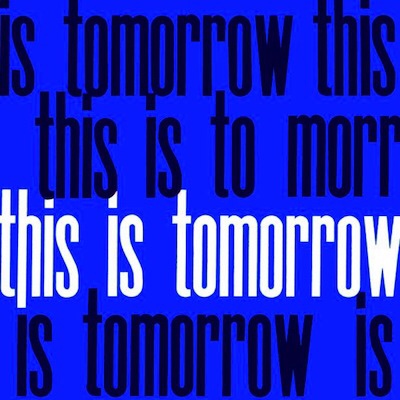
Spiral bound paperback, 132 pages, 165 x 165 mm | ISBN 978-0-8548-8186-4 | Reissued 2010
A facsimile of the original catalogue to accompany the seminal 1956 exhibition This is Tomorrow that took place at the Whitechapel Gallery, initiated by the Independent Group.
Designed by Edward Wright, and originally printed and published by Lund Humphries, this faithful reissue features a two page insert containing a short preface by Iwona Blazwick and curator Nayia Yiakoumaki.
• Artland: The Shows That Made Contemporary Art History: This Is Tomorrow
• Wikipedia: “This is Tomorrow” exhibition article
• Wikipedia: Independent Group (art movement) | Archived Web Site edited by Anne Massey on Wayback
Most often valourised as the fathers of pop, the broader contribution of the Independent Group to critical thinking and creative practice about visual culture has been under-rated. Leading artists such as Richard Hamilton, Eduardo Paolozzi and William Turnbull; architects Alison and Peter Smithson, James Stirling and Colin St John Wilson and critics Lawrence Alloway and Reyner Banham all contributed to the interdisciplinary, group events.
• Art Review: A contemporary review of the “This is Tomorrow” exhibition
• The History of Exhibitions: Beyond the Ideology of the White Cube (PDF, 2009)

Rocket was a short-lived sci-fi adventure comic which ran for 32 weeks, published in 1956, produced by the News of the World, which followed the Daily Mirror and the Daily Express in launching their own boys’ weeklies. Published at the same size as EAGLE, it was printed in photogravure by EAGLE’s printer Eric Bemrose and, like EAGLE, had eight colour and eight black and white pages.
Allegedly edited by the World War Two hero Douglas Bader, who is profiled in this book, the actual editor was Ross Lewis, who assembled a team of accomplished science fiction writers to contribute stories and check the accuracy of the scientific information in the weekly. It featured “Captain Falcon”, drawn by Basil Blackaller (as “Frank Black”), on the cover, and also included reprints of American strips like “Flash Gordon”, “Johnny Hazard” and “Brick Bradford”.
• Buy the Forbidden Planet feature film from AmazonUK (Affiliate Link)
With thanks to Iain Mclumpha and members of the Forbidden Planet – The Movie Facebook Group
The founder of downthetubes, which he established in 1998. John works as a comics and magazine editor, writer, and on promotional work for the Lakes International Comic Art Festival. He is currently editor of Star Trek Explorer, published by Titan – his third tour of duty on the title originally titled Star Trek Magazine.
Working in British comics publishing since the 1980s, his credits include editor of titles such as Doctor Who Magazine, Babylon 5 Magazine, and more. He also edited the comics anthology STRIP Magazine and edited several audio comics for ROK Comics. He has also edited several comic collections, including volumes of “Charley’s War” and “Dan Dare”.
He’s the writer of “Pilgrim: Secrets and Lies” for B7 Comics; “Crucible”, a creator-owned project with 2000AD artist Smuzz; and “Death Duty” and “Skow Dogs” with Dave Hailwood.
Categories: Art and Illustration, British Comics, Comics, downthetubes Comics News, downthetubes News, Events, Exhibitions, Features, Film, Other Worlds